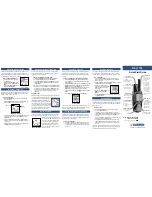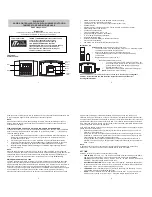
— 2 —
SECTION 1
GENERAL
Getting Started
Installing the Battery
(See Fig.
B
)
1
While pressing the battery
compartment lid, slide it to open.
2
Insert one size AAA (R03) battery (not
supplied) with correct polarity.
3
To close the lid, press and slide the lid
down until it clicks.
When to replace the battery
Replace the battery when the sound becomes
weak or distorted. Remove the old battery and
insert a new one.
Battery life (approximate hours)
Sony
Sony
alkaline
size AAA
size AAA
(R03)
(LR03)
FM reception
80
40
AM reception
100
50
Notes on the battery
• Align the battery correctly.
• The dry battery cannot be charged.
• To avoid damage from possible battery
leakage, remove the battery when unit will
not be used for a long time.
Wearing the Radio
1
Pull out the support band fully from
the headband.
2
Adjust the headband and the support
band to fit your head.
Note on the support band
(See Fig.
A
)
When the radio not in use, put the support band
back by pushing down both ends as illustrated
and push it back underneath the headband.
Note on the light reflector
(See Fig.
A
)
This reflector reflects a car light at night for your
safety.
Playing the Radio
1
Set
POWER
to
ON
.
2
Set
BAND
to select
FM
or
AM
.
For FM, set
SENS
to
LOCAL
if interference is
prevalent and reception is too strong. Under
normal condition, set it to
DX
.
3
Turn
TUNE
(tuning) to tune in a station.
4
Adjust the volume using
VOL
.
To turn off the radio
Set
POWER
to
OFF
.
AAA (R03) x 1
Head band
Light reflector
FM flexible
antenna
BAND
SENS
VOL
Driver
units
POWER
Support band
Insert the
#
side of the
battery first.
Battery
compartment
Dial scale
A
TUNE
B
This section is extracted from
instruction manual.
1.
Check the area of your repair for unsoldered or poorly-soldered
connections. Check the entire board surface for solder splashes
and bridges.
2.
Check the interboard wiring to ensure that no wires are
"pinched" or contact high-wattage resistors.
3.
Look for unauthorized replacement parts, particularly
transistors, that were installed during a previous repair. Point
them out to the customer and recommend their replacement.
4.
Look for parts which, through functioning, show obvious signs
of deterioration. Point them out to the customer and
recommend their replacement.
5.
Check the B+ voltage to see it is at the values specified.
6.
Flexible Circuit Board Repairing
• Keep the temperature of the soldering iron around 270˚C
during repairing.
• Do not touch the soldering iron on the same conductor of the
circuit board (within 3 times).
• Be careful not to apply force on the conductor when soldering
or unsoldering.
SAFETY CHECK-OUT
After correcting the original service problem, perform the following
safety checks before releasing the set to the customer.




























